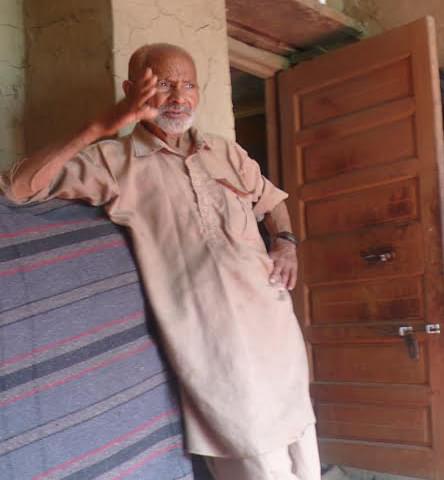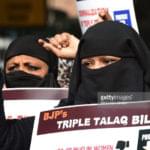Opinions
Chachal Graveyard: Where a Blind Guards the Unknown Dead

Uri (Kashmir):
Izhar Nazir Ali:
This is the story of Atta Mohammad Khan, 69, who doesn´t know the dead or their names but has the expertise in burrying the dead. He can remember them by the ´bullet wounds and torture marks´. After all it is not names but the marks that leave an everlasting impression in ones memory.
Atta Mohammad is the ´Graveyard Man´. After burying over 230 nameless and no identity people, Khan, the lone caretaker of Chachal Graveyard in Uri´s Bimbyar village is exhausted. His old eyes have lost sight, yet a peep into the past makes unwanted tears roll. These tears that shine on his cheeks hold the secret tales of the unmarked graves where nameless dead dubbed as militants lay buried.
The Graveyard is now known as the ´last space for nameless people who except for security personal no one comes to see them off in their last journey´.
From a year old infant to people as old as him, Khan has been a part of their journey to the ´unknown after death life´. “A year old girl, who was flung into river Jhelum by her mother, while she was escaping the wrath of army troopers searching for her family, lies buried here,” he recalls.
Chachal had to take care of the nameless dead, soon after neighbouring Kichama Graveyard had no space left for them. Khan claims that 235 persons were buried in the graveyard in six years and there is no space left now.
On an occasion, he recalls, he dug nine graves in a day and at times the dead shared a grave. “I dont know them personally nor do those who come to bury the nameless. One morning as I buried two bodies, a group of five people sitting under a faraway tree were watching us. The following day, one of them, Ghulam Mohi-Ud-Din, came to me here and said that one of the buried men the day before happened to be his son,” he says.
Ironically, Din, a resident of Jalshiri village was unaware that his son was being buried while he stood few meters away watching. In such cases where the dead were later identified as someone from the village, Khan suffers another ordeal. The dead was later exhumed after orders from the adminsitration. As he says, “I requested Din, even after he got permission from the Deputy Commissioner for exhumation of his son´s body, not to open the grave. I never wanted such humiliation for the dead.” The family refused his request and Din´s son was exhumed quickly for religious rituals and investigation. That later bacame a huge political issue.
There were also the dead who were brought out after many days. Khan says that a body of a youth from Haigam village in Sopore was exhumed a week after his burial.
At one point in 2004, two years after he took the job of the caretaker, police had asked Khan to dig eight graves. They asked him to leave the place as bodies could not reach till the next day. “The next morning, I went to visit my daughter in the neighboring village, and on my return, I saw all the empty graves filled,” Khan recounts.
It was only after being told by a villager did he discover that his nephew Salim Khan was also among those buried covertly by the police.
At times he ´resisted´ the police who used to keep the dead person´s belongings. “One night, the police told me to bury two bodies. One was a middle aged man and the other was in his 20s. When I started burying the younger one, the policemen saw the watch that he was wearing and asked me to take it off. I refused. Later, the policemen took it away.
I wept,” he laments. In the same year in 2004, Khan received five bodies – of these, two had the flesh on their legs torn and their bones were visible. “I tied their legs with cloth and cleaned the blood stains that covered their bodies. At one point, I felt as if they were alive,” Khan recalls. Unable to see these days, he, however, remembers the dead by their wounds
Such gory sights would often get him into heated arguments with the troops and the police. “The army used to keep the bodies in sacks and then drag them from mountain top. At times, they used to throw the bodies from the top to their colleagues at the base of the mountain,” he says, adding that sometimes the bodies would remain in the open for days.
Many times he posed a question about the where abouts of the dead to the Indian forces, but they meted out a ´standard reply´. “I always asked the army and police to reveal the identity of the slain, but every time they said that he is an ugarwadi (terrorist),” says Khan.
Of the 235 buried, very few have been identified. People from as far as Shopian and Srinagar have visited the graveyard in search of their missing relatives.
“The family members of the missing come to the graveyard to relieve themselves from pain and agony. They cry on the graves before leaving,” he recounts.
The people who come looking for their own often have numerous questions for him.
The answers for which he has none.
After all the dead at Chachal have but onw name, ´Ugrawadi´. “Some people ask me about the looks of the buried person. Where they were shot? If they had any signs of torture on their bodies?”
The toll of guarding the unknown dead is far too evident on Khan´s face. “I can´t sleep properly. I have lost my eyesight now, but I still want to guard the dead. that is my way of serving people. Atleast even the dead deserve a respectable end,” he says in his broken voice.
